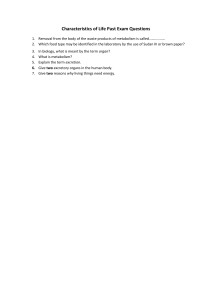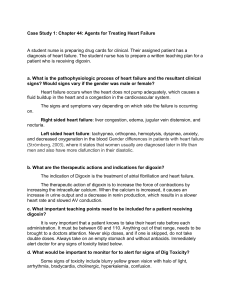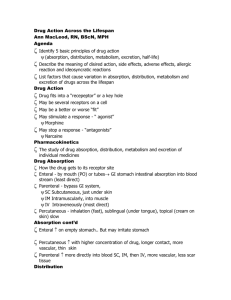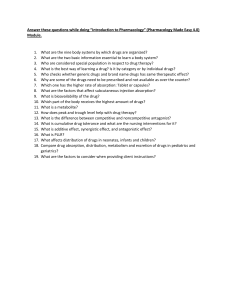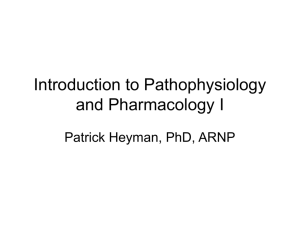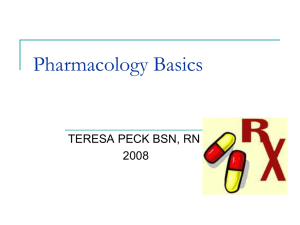Drug Interactions: Mechanisms, Outcomes, and Risk Categories
advertisement
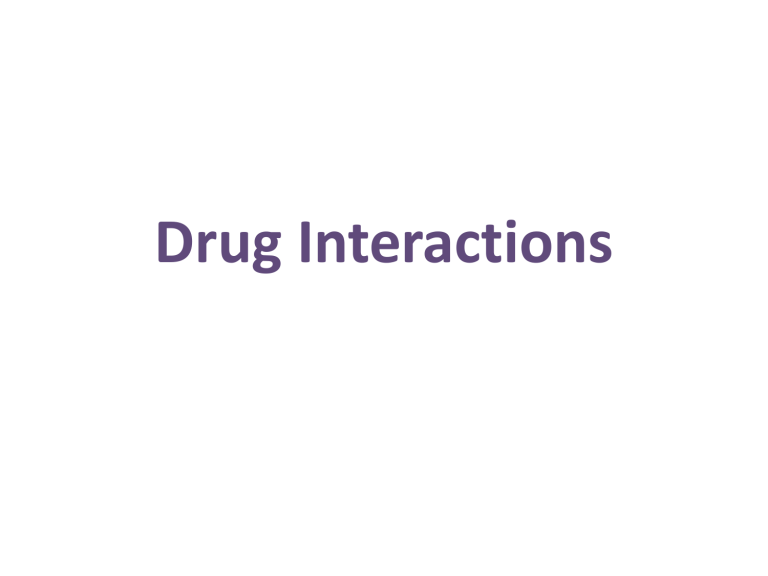
Drug Interactions Definition of drug interactions: An interaction occurs when effects of one drug are changed by the presence of another drug, herbal medicine, food, drink or by some environmental chemical agent. Object drug: drug whose action is changed Precipitant drug: drug that cause altered effect Types of DI according to precipitant agent: • Drug-drug interaction • Drug –food interaction (tetracycline-milk) • Drug-disease interaction (renal, hepatic, malabsorption syndrome, hyper\hypothyroidism • Drug-pollutant interaction (nicotine, PCAH) • Drug-packaging interaction (sorption ,permeation) • Drug-lab test interaction(theophylline interferes with uric acid analysis) • Physical incompatibilities Outcome of DI: 1- harmful effect either: • Reduced effect • increased effect with risk of toxicity 2- beneficial effect either: • Enhancement of effect (β-blocker+diuretic) • Elimination of toxicity (sodium bicarbonate +aspirin, ascorbic acid+ amphetamine) • Risk categories of drug interactions: • Risk category A and B are of academic, but not of clinical concern. • Risk category “A” corresponds to no evidence of drug interaction while category “B” denotes the presence of evidence for potential interactions but with little evidence for clinical concern. • Risk category “C” where there is evidence of potential interaction which is clinically significant. However, the benefits usually outweigh the risks. • Risk category “D” Therapy modification is to be considered for category “D,” which may involve dose adjustment, considering alternative therapy, aggressive monitoring to minimize toxicity. • Risk category “X”: Drug combinations in the risk category “X” are to be avoided since the risks usually outweigh the benefits. Such drug combinations are considered contraindicated Factors affecting DI: • Sequence of administration • Dosage form • Dose • Disease • Age • Genetic factors Mechanisms of drug interactions • Pharmacodynamic interaction (additive\antagonism • Pharmacokinetic interactions Pharmacokinetic interactions affect the processes by which drugs are absorbed, distributed, metabolized and excreted (ADME) 1- Drug absorption interactions Drug absorption may be affected by: drugs- disease-fluid intake- food • Grisofulvin+fatty meal : increase bile acid secretion, improve grisofulvin (lipophilic) dissolution absorption • Macrolides+food: 50% decrease absorption So macrolides should be taken on empty stomach But erythromycin causes nausea, vomiting Solution: enteric coating 1- Effects of changes in gastric pH Antacids affect drugs by different mechanisms: • Increase gastric PH (weakly acidic drugs salicylic acid) increase its ionization, decrease nonionized form, absorption • Urine alkalinization (weakly acidic drugs salicylic acid) increase its ionization, decrease nonionized form, increase excretion • Adsorption • chelation (tetracycline) • Slowing gut motility (aluminum containing antacids • H2 blockers (cimetidine,rantidine,famotidine) • Proton pump inhibitors (omeprazole, pentaprazole, esmoprazole, lanzoprazole) • Anticholinergics as pirenzepine decrease gastric secretion Also affect gastric PH and affect absorption of weak acids as salicylates • Ketoconazole (require acidic medium dissolution and absorption) Antacids, H2-receptor antagonists, proton pump inhibitors + Ketoconazole • Outcome: Reduced Ketoconazole absorption • Pravastatin (require basic medium dissolution and absorption) Antacids, H2-receptor antagonists, proton pump inhibitors + Ketoconazole • Outcome: increase pravastatin absorption 2-Changes in gastrointestinal motility(gastric emptying) • delays gastric emptying: ✓ anticholinergic: Propantheline ✓ Antipsychotics: chloropromazine, haloperidol ✓ TCA: imipramine,amitryptiline ✓ narcotic analgesics :pethidine, dimorphine ✓ ganglionic blockers :mecamylamine • increases gastric emptying ✓ Antiemetics, prokinetic drugs:Metoclopramide, cisapride, mosapride ✓ cholinergic drugs ✓ large volume of fluid 1- Affect rate not extent of absorption • single dose drug • Rapidly soluble drugs (paracetamol) • Potent single oral dose where rapid effect is requires as hypnotic or paracetamol • Propantheline + paracetamol Outcome: decrease rate of absorption, delay analgesia • Metoclopramide+ paracetamol Outcome: increase rate of absorption 2- poorly soluble drugs: digoxin, dicumarol, warfarin Propantheline + Digoxin • Digoxin levels increased (slow-dissolving) digoxin tablets. • No interaction with liquid or fast-dissolving tablets Mechanism • Propantheline reduces gut motility, allows slow-dissolving digoxin more time to pass into solution so that more is available for absorption. Metoclopramide + slow-dissolving tablets Digoxin Outcome: Reduced digoxin absorption 3- multiple dose drugs as warfarin: Change in gut motility has no significant effect on steady state concentration 4- acid labile drugs • Propantheline +acid labile drugs (antibiotics): increase destruction of drugs, decrease absorption, decrease serum level and effect 5-drugs under intestinal metabolism • Propantheline + drugs under intestinal metabolism (L-dopa) Increase exposure of L-dopa to metabolizing enzyme reduced absorption, decrease serum level and effect 3- Binding in gut: Adsorption: and complexing mechanisms • Activated charcoal/kaolin , pectin in antidiarrheal mixtures • Antacids can also adsorb drugs • chelation • Divalent/trivalent metallic ions, such as Ca, Al, Fe (dairy products , antacids) complexes with tetracycline • Antacids with Mg,Al and iron prepration reduce absorption of pencillamine due to chelation • Separation 3-4 hr can prevent this interaction • Binding :Colestyramine binds to many drugs (warfarin, thyroxin, digoxin, pravastatin) Separation 3-4 hr can prevent this interaction • Antacids with Mg,Al and iron preparation reduce absorption of quinolone due to formation of poorly soluble complex • Dicoumarol form more soluble complex with magnesium hydroxide antacids increase the absorption of dicoumarol (beneficial interaction) 4- Malabsorption caused by drugs Destruction of gut mucosa by neomycin, cytotoxic drugs as MTX, 5FU impair the absorption of drugs 5- reduction of gut flora population: • Antibiotics + oral anticoagulant Antibiotics decrease population of gut flora responsible for vit k synthesis so potentiate effect of oral anticoagulant 6- Induction/inhibition of drug transporter proteins • Transporter proteins (P-glycoprotein) eject drugs that have diffused across gut lining back into gut. Digoxin + rifampicin • Digoxin is a substrate of P-glycoprotein, • rifampicin (induce this protein), • Outcome: reduce the bioavailability of digoxin 2- Drug distribution interactions Many drugs transported with some proportion of their molecules in solution (free form) and the rest bound to plasma proteins, particularly the albumins, both forms are in an equilibrium. • Free form is pharmacologically active (metabolized) , bound form is pharmacologically inactive reservoir • As the free molecules become metabolized, some of the bound molecules become unbound and pass into solution to exert their pharmacological effect in their turn are metabolized and excreted • Depending on the concentrations and their relative affinities for the binding sites, one drug may successfully compete with another and displace it • The displaced (free) drug molecules pass into the plasma and their concentration rises. • However, this rise is transient due to metabolism and excretion Clinically significant displacement reaction occur if: 1- Displacing drug inhibit metabolism or excretion displaced drug 2- Displaced drug has narrow therapeutic index • Phenyl butazone + warfarin: Phenyl butazone displaces warfarin from plasma protein binding sited and inhibit its metabolism, increases warfarin conc and effect • Aspirin+ warfarin: PD: additive effect, PK: displacement • Kernicterus :physiological displacement reaction between sulfonamide and bilirubin (neurotoxic substance) leading to brain damage • Highly bounded to PP: salicylate, sulfonamide, phenyl butazone, warfarin ,phenytoin, chloropromamide glibenclamide 3- Drug metabolism interactions • Drug metabolism goes on in the serum, the kidneys, the skin and the intestines, but the greatest proportion is carried out by enzymes of liver cells ‘liver microsomal enzymes, cytochrome P450’. MFO mixed function oxidases • Cytochrome P450 is not a single entity, but is in fact a very large family isoenzymes • The most important isoenzymes are CYP1A2, CYP2B6, CYP2C8, CYP2C9, CYP2C19, CYP2D6, CYP2E1 and CYP3A4. (A) Enzyme induction • increase the activity of the microsomal enzymes and metabolism, decrease serum conc and effect • It may take 7-10 days to develop and may persist for a similar length of time when the enzyme inducer is stopped. Enzyme induction interactions are delayed in onset and slow to resolve. • Management: simply by raising the dose of the drug affected, this requires good monitoring • Enzyme inducers: barbiturates (tolerance), phenytoin,primidone, Carbamezipine,refampicin, smoking, chronic alcoholism, DDT insecticide (B) Enzyme inhibition • Reduced metabolism of an affected drug leads to its accumulate within the body, increase serum level, effect, toxicity • enzyme inhibition can occur rapidly, resulting in the rapid development of toxicity and persist after withdrawal depending on its t1\2 (usually persist 4t1\2) • Enzyme inhibitors: choramphenicol,erythromycin ciprofloxacin,isonaizide,ketoconazole,allopurinol, fleuxetine,verapamil,amiodarone,cimetidine, omeprazole, phenyl butazone, valproate, MAO inhibitors, acute alcholism, disulfuram 4- Drug excretion interactions (a)Changes in renal blood flow • Renal blood flow(RBF)is partially controlled by the production of renal vasodilator prostaglandins • NSAIDs inhibit synthesis of renal vasodilator prostaglandins, decrease RBF, reduce renal excretion of drugs • NSAIDs + lithium NSAIDs reduce renal excretion of lithium, increase its serum level with expected toxicity (tremors, leukocytosis, dyskinesia) (b)Changes in urinary pH • Passive reabsorption of drugs in non-ionized lipidsoluble form, depends on its pKa and urine pH • Urine acidification(ammonium chloride,ascorbic acid ➢Weakly basic drug (amphetamine): Increase its ionization, decrease non-ionized portion, reabsorption and increases its excretion ➢Weakly acidic drug (aspirin, barbiturate) decrease its ionization, increase non-ionized portion, reabsorption and decreases its excretion • Urine alkalinization (sodium bicarbonate,antacids) • Weakly acidic drug (aspirin, barbiturate) Increase its ionization, decrease non-ionized portion, reabsorption and increases its excretion Weakly basic drug (amphetamine,quinidine, mecamylamine): decrease its ionization, increase non-ionized portion, reabsorption and decreases its excretion (c) Changes in active tubular secretion excretion • Drugs that use the same active transport systems in the renal tubules can compete for excretion • Penicillins, Cephalosporins + Probenecid Outcome: probenecid reduces the excretion of penicillin, increase t1\2 (beneficial interaction) • Quinidine + digoxin: decrease digoxin excretion, cause digoxin toxicity (dose dependent DI>1200mg • Aspirin+ MTX: displacement, decrease RBF, competition for active tubular secretion High risk of MTX toxicity (myelosupression, mucositis Pharmacodynamic interactions Effects of one drug are changed by the presence of another drug at its site of action either by competing for particular receptors or indirect by interference with physiological mechanisms. • Additive or synergistic interactions two drugs that have the same pharmacological effect are given together • CNS depressants + CNS depressants Outcome: excessive drowsiness, risk of respiratory depression Alcohol + Antihistamines Benzodiazepines + General Anesthetics Opioids + Benzodiazepines • Antipsychotics + Anticholinergic • TCA + Anticholinergic Outcome: potentiate anticholinergic effects (heat stroke in hot and humid conditions, adynamic ileus, urine retention…) • Nephrotoxic drugs + Nephrotoxic drugs (Aminoglycosides, Cyclosporin, Cisplatin, cephalosporins) Outcome: Increased nephrotoxicity • Potassium supplements + K-sparing drugs (ACE inhibitors, ARBs, K-sparing diuretics) Outcome: Hyperkalaemia • Ototoxic drugs + ototoxic drugs (Aminoglycosides, ethacrynic acid) Outcome: : Increased ototoxicity Antagonistic or opposing interactions • Anticoagulants + Vitamin K Outcome: antagonize anticoagulant effects • Thaizide (hyperuricemia) +allopurinol (antigout) • Antidiabetics + corticosteroids, thiazide Outcome: antagonize blood glucose-lowering effects • Caffeine+ hypnotics Outcome: antagonize hypnotic effect • Beta blocker + beta2 agonist bronchodilator Outcome: antagonize bronchodilator effect Peripheral adrenergic neurons Propranolol + salbutamol • Outcome: Propranolol antagonize bronchodilator effects of salbutamol Tricyclic antidepressants + noradrenaline TCA block the uptake mechanism by which noradrenaline is taken into the neuron and removed from the receptor area. As a result the effects of administered noradrenaline are exaggerated (severe hypertension) MAOIs + indirectly-acting sympathomimetics (amphetamine) • Indirectly-acting sympathomimetics stimulate the release of noradrenaline • MAOIs inactivate monoamine oxidase (MAO) and cause the accumulation of NA at nerve ending • Outcome: massive stimulation of the receptors and a grossly exaggerated pressor response (severe hypertension) Tricyclic antidepressants + guanethidine • Guanethidine exert hypotensive action firstly by entering adrenergic nerve endings in blood vessels using monoamine reuptake pump. • TCA prevent the uptake of guanethidine into the neurones, thereby blocking its antihypertensive effects • Interactions due to electrolyte imbalance: • Digoxin+ thaizide (digoxin toxicity) • Lithium carbonate +sodium restricted diet increase Li renal tubular reabsorption leading to Li toxicity • Reduction of hepatic blood flow: • Propranolol+ lidocaine : Lidocaine has narrow TI undergoes first pass metabolism Propranolol decrease myocardial contractility, hepatic perfusion, lidocaine metabolism, increase serum level and lead to toxicity • Evaluation of DI: 1- pharmacodynamics and s\e 2- PK 3- doses: quinidine\digoxin 4- diet: milk\Tc , tea\Fe, caffiene\hypnotics, vit k \warfarin, smoking, alchol, charcoal broiled food 5-residual effect of drugs: MAOI, amiodarone t1\2 6- narrow TI: aminoglycosides, digitalis, Li, theophylline, phenytoin 7- age : neonates, eldrly more susciptible 8- environmental factor: smoking, DDT, PCAH, 9- disease state: renal, hepatic disease, diarrhea, malabsorption syndrome Hypothyroidism (low metabolism) sensitive to digoxin, theophylline aminophylline, oxitriphylline (xanthine except dyphylline) But need higher doses of warfarin due to low metabolism of clotting factors 10-pharmacological class: H2 blockers cimetidine only affect matabolism Ca channel blockers: verapamil only inhibitor not Nifidipine, deltiazem Nifidipine+propranolol (PDI) Verapamil+propranolo (PDI+PKI) 11- prodrugs require activation as: tamoxifen, 5FU, clopidogril Clinical application of beneficial DDI: Migracid (paracetamol+metoclopramide): rapid effective treatment of migraine and decrease nausea and vomiting symptoms accompanying migraine
